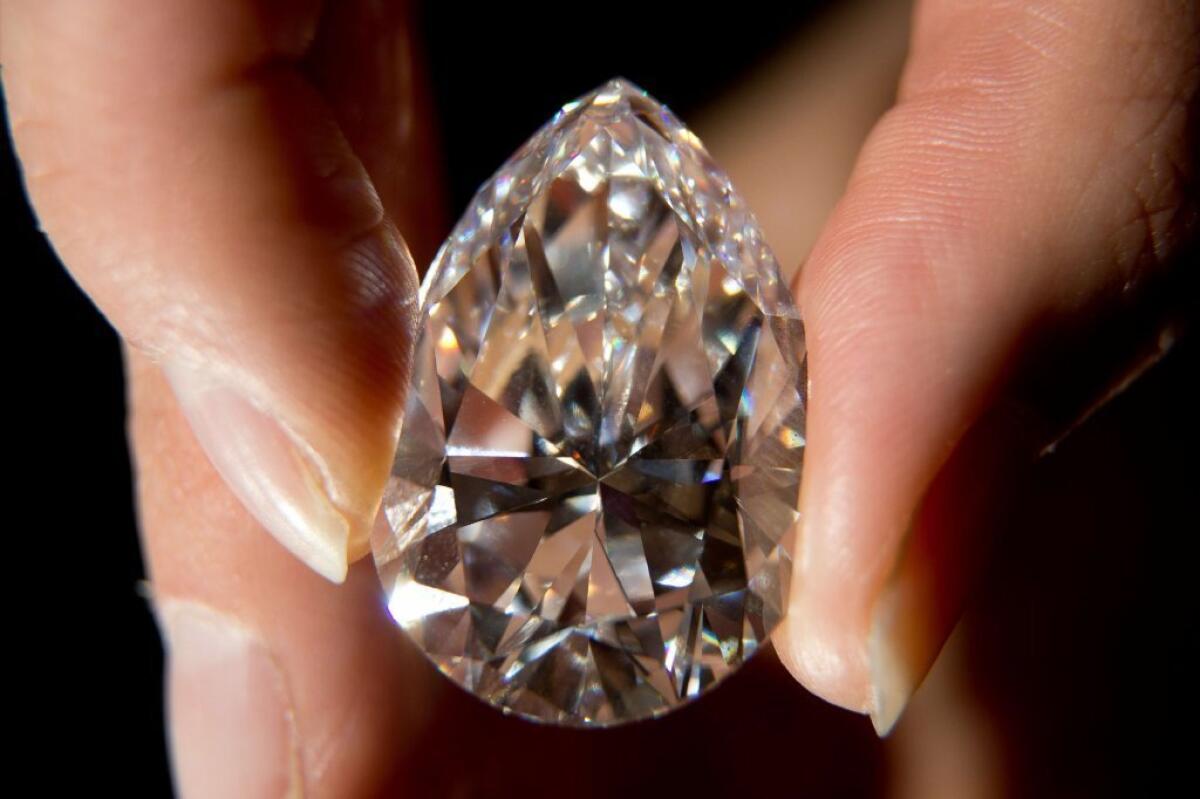Tiny new synthetic diamonds increase strength of girl’s best friend

- Share via
Diamonds may be a girl’s best friend, but they’re also prized by oil drillers, road crews and experimental physicists for their unparalleled ability to bore, grind and cut. Now scientists have synthesized microscopic diamonds that are harder, tougher and more stable than any made in nature or in a lab.
These new nanodiamonds boast a special pattern in their crystal structure called nanotwinning, in which adjacent crystals share an interlacing boundary and grow into mirror images of one another. That twinning gives the diamonds their extraordinary hardness, the researchers say in a study published in Thursday’s edition of the journal Nature.
It may come as a surprise that most diamonds are used not in engagement rings but for industrial purposes. Diamonds make sharp drill bits that penetrate the Earth’s crust in search of fossil fuels and minerals. They form blades that grind down uneven road surfaces and immaculate crystals for conducting precise scientific experiments. You can even purchase fine diamond powders for polishing glass from Amazon.com.
But these functional diamonds need more than hardness to withstand the rigors of rough work. Paradoxically, harder diamonds tend to fracture more easily, so scientists have long sought ways to make tougher materials that won’t break under stress.
Industrial diamonds also need to remain intact when subjected to high temperatures, a property scientists call thermal stability. Regular diamonds are technically unstable at Earth’s surface, although you are unlikely to notice your gems withering away because the reaction that converts them to graphite requires a high dose of energy. But they do wear out when heated up in the process of cutting, grinding and polishing.
Scientists have already found ways to produce diamonds that are harder, tougher or more stable than those made by nature (diamonds form when carbon is compressed deep in Earth’s mantle). Unfortunately, synthetic diamonds often involved tradeoffs -- when one quality (like hardness) got better, another (like toughness) got worse.
Until now. Scientists at Yanshan University in China say that diamonds made with their new method surpass existing diamonds in every category.
The new nanodiamonds measure between 20 and 50 nanometers across, slightly larger than other nanodiamonds. But unlike their predecessors, they contain twinning structures as small as 5 nanometers. That’s roughly twice the thickness of a single strand of DNA.
“At these twinning boundaries, the crystals on each side are bonding together much better,” said Bo Xu, a materials scientist who helped lead the study.
The nanotwinning accounts for the diamonds’ hardness while the small crystal size lends stability and makes them more resistant to fractures. Each pinhead-size sample contains a multitude of nanodiamonds whose many twinning boundaries help absorb a force that would otherwise break it, Xu said.
All of these advantages can be traced to the properties of a funny little nanoparticle called onion carbon, the raw ingredient in the scientists’ diamond recipe that they say deserves credit for their success. With a dozen or so nested spheres of carbon atoms, the molecule bears an obvious resemblance to its namesake. The scientists cooked these molecules at extremely high temperatures and pressures -- akin to the conditions deep in Earth’s molten mantle -- until tiny diamond crystals began to grow.
The scientists then put their nanotwinned diamonds to the test by crushing them with a natural diamond crystal and looking for an imprint. They found that the new diamonds could withstand pressures about two to three times greater than natural diamonds. They also weathered strong forces without cracking and remained stable at temperatures up to 1,056 degrees Celsius -- more than 200 degrees hotter than natural diamonds.
These nanodiamonds are “extraordinary,” Jim Boland, a diamond expert at the Commonwealth Scientific and Industrial Research Organization in Australia, wrote in a commentary that accompanies the study.
But others aren’t so sure. Dr. Natalia Dubrovinskaia, a crystallographer at the University of Bayreuth in Germany, said the testing method simply doesn’t make sense. She questioned the logic of testing something that’s supposedly harder than a diamond by comparing it to diamond. It would be like trying to measure the hardness of a stainless steel knife by pressing it against an aluminum fork, she said: “The result of such an attempt will be broken teeth of the fork.”
Munawar Chaudhri, a materials scientist at the University of Cambridge shares Dubrovinskaia’s concerns.
“I would like to ask them to make an indenter tip of their nanotwinned diamond and then try to show that this tip can indent a flat surface of a natural diamond crystal,” he said.
Xu and his colleagues think this critique oversimplifies their testing method. They say it all depends on how the forces are applied. Diamond crystals have greater strength in one direction than the other. Because the compression strength of the diamond crystal indenter greatly exceeds the shear strength of the nanotwinned diamond being tested in the study, they say the technique is reliable.
Questions remain about how to produce nanotwinned diamonds at an industrial scale, but there’s sure to be plenty of interest, according to Boland, who was not involved in the research.
“The properties of these nanotwinned diamonds are exceptional, and there are likely to be many niche areas in which samples of the material can be gainfully employed,” he said. These include drug delivery, where nanodiamonds might ferry chemicals to cancer cells, and diamond anvil cells, the contraptions used by geologists and physicists to subject rocks and metals to exceedingly high pressures.
For all things science, follow me @ScienceJulia




